
For this task, students answer questions using their knowledge of interger exponents.
- Subject:
- Mathematics
- Material Type:
- Activity/Lab
- Provider:
- Mathematics Assessment Project/MAP
- Date Added:
- 03/23/2017

For this task, students answer questions using their knowledge of interger exponents.

This is a task from the Illustrative Mathematics website that is one part of a complete illustration of the standard to which it is aligned. Each task has at least one solution and some commentary that addresses important asects of the task and its potential use. Here are the first few lines of the commentary for this task: A penny is about $\frac{1}{16}$ of an inch thick. In 2011 there were approximately 5 billion pennies minted. If all of these pennies were placed in a s...
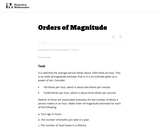
This is a task from the Illustrative Mathematics website that is one part of a complete illustration of the standard to which it is aligned. Each task has at least one solution and some commentary that addresses important asects of the task and its potential use. Here are the first few lines of the commentary for this task: It is said that the average person blinks about 1000 times an hour. This is an order-of-magnitude estimate, that is, it is an estimate given as a power...

This is a task from the Illustrative Mathematics website that is one part of a complete illustration of the standard to which it is aligned. Each task has at least one solution and some commentary that addresses important asects of the task and its potential use. Here are the first few lines of the commentary for this task: The local swim center is making a special offer. They usually charge \$7 per day to swim at the pool. This month swimmers can pay an enrollment fee of ...

This 8th grade Math parent guide explains the content in straightforward terms so they can support their children’s learning at home and will encourage caretaker engagement with lessons.

Our Teacher Guides are meant to support the use of our online course and unit content. Please use these to accompany the use of our content and for ideas to support struggling learners, those needing extension and for additional resources.

In this problem students are comparing a very small quantity with a very large quantity using the metric system. The metric system is especially convenient when comparing measurements using scientific notations since different units within the system are related by powers of ten.
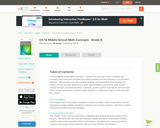
In CK-12 Middle School Math Concepts Grade 8, the learning content is divided into concepts. Each concept is complete and whole providing focused learning on an indicated objective. Theme-based concepts provide students with experiences that integrate the content of each concept. Students are given opportunities to practice the skills of each concept through real-world situations, examples, guided practice and explore more practice. There are also video links provided to give students an audio/visual way of connecting with the content.

In this activity, the students will demonstrate the ability to represent numbers in scientific notation and use geometry to solve problems about planets in the solar system.
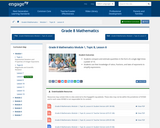
In this lesson, students compare and estimate quantities in the form of a single digit times a power of 10. Students use their knowledge of ratios, fractions, and laws of exponents to simplify expressions.
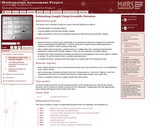
This lesson unit is intended to help teachers assess how well students are able to: estimate lengths of everyday objects; convert between decimal and scientific notation; and make comparisons of the size of numbers expressed in both decimal and scientific notation.
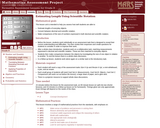
This lesson unit is intended to help you assess how well students are able to:
* Estimate lengths of everyday objects.
* Convert between decimal and scientific notation.
* Make comparisons of the size of numbers expressed in both decimal and scientific notation.

The purpose of this lesson is to teach the students about how a spacecraft gets from the surface of the Earth to Mars. The lesson first investigates rockets and how they are able to get us into space. Finally, the nature of an orbit is discussed as well as how orbits enable us to get from planet to planet specifically from Earth to Mars.

Students will expand their basic knowledge of positive integer exponents and prove the Laws of Exponents for any integer exponent. Next, students work with numbers in the form of an integer multiplied by a power of 10 to express how many times as much one is than the other. This leads into an explanation of scientific notation and continued work performing operations on numbers written in this form.
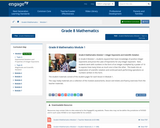
In Grade 8 Module 1, students expand their basic knowledge of positive integer exponents and prove the Laws of Exponents for any integer exponent. Next, students work with numbers in the form of an integer multiplied by a power of 10 to express how many times as much one is than the other. This leads into an explanation of scientific notation and continued work performing operations on numbers written in this form.

Students will extend what they already know about unit rates and proportional relationships to linear equations and their graphs. Students understand the connections between proportional relationships, lines, and linear equations in this module.
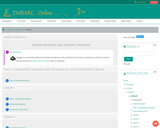
Grade 8 Module 1: Integer Exponents and Scientific Notation. Contains 13 Lessons.
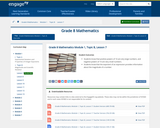
In this lesson, students know that positive powers of 10 are very large numbers, and negative powers of 10 are very small numbers. Students know that the exponent of an expression provides information about the magnitude of a number.

In this lesson, students represent numbers in scientific notation, and use geometry to solve problems related to three-dimensional figures. They will also explore distance and capacity problems about planets in the solar system.

For this task, students work with radicals and integer exponents to answer determine the weight of a million dollars in dollar bills and the number of burgers that can be purchased for a million dollars.